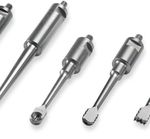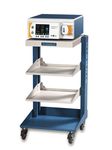Ultrasonic Surgical Debridement - Controlled tissue removal Decreased healing times1 Reduced bleeding2 Reduction of biofilm3-5
←
→
Page content transcription
If your browser does not render page correctly, please read the page content below
SonicOne O.R.
®
Ultrasonic Surgical
Debridement
■■ Controlled tissue removal
■■ Decreased healing times1
■■ Reduced bleeding2
■■ Reduction of biofilm3-5
RThe Ultrasound
SonicOne O.R.
The Misonix SonicOne O.R. System is an innovative ultrasonic
surgical device that allows surgeons to address the challenges
Advantage chronic wounds present to them, the patient, and the health-
care system. SonicOne O.R. establishes a new standard in
surgical wound bed preparation, an essential first step in the
wound healing process.
®
The SonicOne O.R. generator converts standard The SonicOne O.R. has been designed to optimize
wall voltage to a 22.5 KHz electrical signal. Which the well known capabilities of high intensity, low
is then transferred, via a cable assembly, to the frequency ultrasound to disrupt, inactivate and
handpiece. The handpiece contains piezoelectric remove bacterial organisms from surfaces and
crystals that convert the electrical signal to stimulate the body’s self healing abiltiy.
mechanical vibrations. The titanium alloy probe,
The design of the individual wound care probes allows
attached to the handpiece distal end, amplifies the
them to effectively debride a variety of wound shapes
mechanical vibration and transfers the acoustic
and a variety of tissue types. Clinical applications
energy into the tissue via direct contact. The
include, but are not limited for use in, the debridement
resulting cavitation, mechanical and hydrodynamic
of wounds, including diabetic foot ulcers, venous
effects produce tissue disruption, excision,
ulcers, pressure sores, burns and bone.
fragmentation and emulsion in the wound bed.
2Features and Benefits
■■ Intuitive, user friendly design allows surgeons to quickly ■■ Automatic gain control function maintains the selected
learn and fully utilize the system amplitude, regardless of the type of tissue being debrided
■■ The ultrasonic movement of the probe allows the surgeon to ■■ Integrated peristaltic pump provides a steady irrigation rate
remove tissue in a controlled and precise manner, reducing to the wound site for cleaning and maintenance of a safe
the bleeding typically associated with surgical debridement 2 wound bed temperature. Irrigation level can be adjusted
■■ Interchangeable wound care probes provide flexibility from a lower setting for debridement to a higher setting for
to address a variety of different wound types, including wound cleansing
tunneling and undermining wounds ■■ Compact design can be easily placed on a cart for maximum
■■ Adjustable amplitude setting provides an easy way to control portability between operating rooms
the aggressiveness of the debridement, addressing a wide ■■ The SonicOne O.R. has been designed to optimize high
variety of wounds and tissue types (necrotic tissue, fibrin, intensity, low frequency ultrasound’s ability to stimulate the
necrotic bone, eschar, etc.) body’s self-healing process, resulting in faster healing rates
■■ System monitoring for easy identification of fault conditions and increased closure rates1
with audible and visual alarms
3Surgical Debridement Cases
“In many cases, when standard wound care does not “Our success in healing wounds can be attributed to the
produce the desired level of improvement, surgical addition of the use of this innovative device in our facility.
debridement is required. The use of ultrasonic surgical The ability to select from a variety of specialty tips
debridement is an excellent option. It allows me to be allows us to address all wound shapes and sizes.
very aggressive in the removal of non viable tissue We have been able to easily excise tissue and remove
within the wound bed. It also allows me to remove necrotic tissue, establishing a clean wound bed. In the
healthy tissue, as required, with minimal bleeding. Net past we would have used a scalpel, but now we can
result; a clean wound bed which is critical for many achieve better results with the added benefits of low
post debridement procedures, such as the application frequency ultrasound which include less bleeding and
of a skin graft. bacteria control.
In the case below, the use of ultrasonic debridement In the case below, the patient had a large open wound
was our last hope to save this patient’s foot. The use with exposed tendon. The decision was made to send the
of ultrasound allowed me to be very controlled and patient to the OR for debridement using the SonicOne
precise during the debridement procedure, resulting in technology. During surgery, all of the necrotic tissue
an incredible debridement which allowed me to apply a was easily removed, resulting in a clean wound bed.
skin graft immediately post surgical debridement.” Immediately after the debridement a bioengineered skin
substitute was easily applied. With continued care, the
Ira M. Tartack, DPM, FACFAS
patient’s wound is on track to successfully heal.”
NY Community Hospital
Brooklyn, NY William A. Ball Jr., MD, FACS
Frank Aviles, PT, CWS, WCC, FACCWS, CLT
Natchitoches, LA
Pre Debridement Pre Debridement
Post Ultrasonic Debridement Post Ultrasonic Debridement
www.misonix.com 4Probes for Surgical Wound Debridement
The Surgical Debridement Probes are designed to specifically address the needs of different wound types. The unique shape of
each probe allows the surgeon to choose the most appropriate probe based upon the wound. All of the ultrasonic surgical probes
are designed for direct contact with the wound surface, providing maximum wound debridement efficiency. The combination of probe
shape and amplitude settings offer the surgeon a full range of options to match specific debridement requirements; from the removal
of slough or fibrin, to a full excisional debridement.
THE ULTRASONIC THE ULTRASONIC THE ULTRASONIC
CYLINDRICAL PROBE CURETTE STYLE PROBE HATCHED PROBE
can effectively penetrate provides a curved contact has a large hatched
deep, narrow wounds that surface that can be used contact surface. The
are typically very difficult to saucerize (angle) design of this probe allows
to access with a scalpel, the wound edges and for a very aggressive
without making the wound provide direct ultrasonic debridement. This probe
much larger. The probe’s energy to the wound bed. is versatile and can be
cylindrical shape, with The rounded surface used for general large
radially positioned coarse also allows for precise area debridement, while
surfaces, can be highly engagement of specific also capable of performing
aggressive when debriding areas that may require ultrasonic debridement of
tunneling wounds or sinus excision. necrotic bone and thick
tract walls, in addition to eschar.
surface debridement of
larger areas.
www.misonix.com 5Ordering Information
SonicOne O.R. System
Misonix SonicOne O.R. Ultrasonic Wound Debridement System typically includes:
• E- SOGEN-OR Ultrasonic Console, footswitch and accesories
• BCM-HP Ultrasonic Hanpiece (2)
Console can be configured for 110-130V, 60Hz and 200-240V, 50Hz
SonicOne O.R. Reusable Items
E-SOGEN-OR SonicOne O.R. Ultrasonic Console, footswitch and accessories
BCM-HP Ultrasonic handpiece
BCM-H2 Probe cover
E-CWRCH Counter wrench
E-PWRCH Autoclavable Probe Wrench
E-SYSCART System cart
SonicOne O.R. Single Use Items – Sterile
MXB-T Irrigation Tube set
Probes for Debridement
MXC-C1 Curette Style Titanium Probe for Debridement
© 2012 Misonix, Inc. All rights reserved. Printed in the USA. SO-OR 2003-12 REV A
MXC-R1 Cylindrical Titanium Probe for Debridement
MXC-X1 Hatched Titanium Probe for Debridement
References:
1
Voigt, J., Wendelken, M., Driver, V., Alvarez, O. Low Frequency Ultrasound (20-40 KHz) as an adjunctive therapy For Chronic Wound Healing; A Systematic Review of
the literature and Meta- Analysis of Eight Randomized Controlled Trials. The International Journal of Lower Extremity Wounds, December 2011, vol. 10, no. 4 p.190-199.
2
Wendelken, M., Markowitz, L., Comfort, C., et al. Ultrasonic Surgical Debridement vs. Standard Sharp Debridement. Paper presented at Fall 2009 Symposium on
Advanced Wound Care, September 18, 2009, Washington, DC.
3
Johnson, LL., Peterson, RV, Pitt, WG: Treatment of bacterial biofilms on polymeric biomaterials using antibiotics and ultrasound, Journal of Biomaterials Sciences,
Polymer Edition 1998: 9:1177-1185
4
Nichter, Larry S. M.D.; McDonald, Scott M.D.; Gabriel, Kent M.D.; Sloan, Gerald M. M.D.; Reinisch, John F. M.D, Efficacy of Debridement and primary closure of
contaminated wounds: A comparison of methods. Annals of Plastic Surgery; 23:224-230. September 1989.
5
McCulloch, J.M., Kloth, L.C. 2010. Wound Healing: Evidence Based Medicine. Chapter 27, Ultrasound for Wound Debridement and Healing, chapter written by Kloth,
L.C, Niezgoda, J. A. p. 545-575.
Schedule a SonicOne O.R. demonstration by contacting your local
Misonix representative or Misonix Customer Service at 1-800-694-9612 (U.S.)
or +1-631-694-9555 (Int).e-mail: sales@misonix.com
R
1938 NEW HIGHWAY, FARMINGDALE, N.Y. 11735 | +1.631.694.9555 +1.631.694.3285 FAX
MISONIX, INC. | NASDAQ SYMBOL. MSON | MISONIX.COMYou can also read



























































